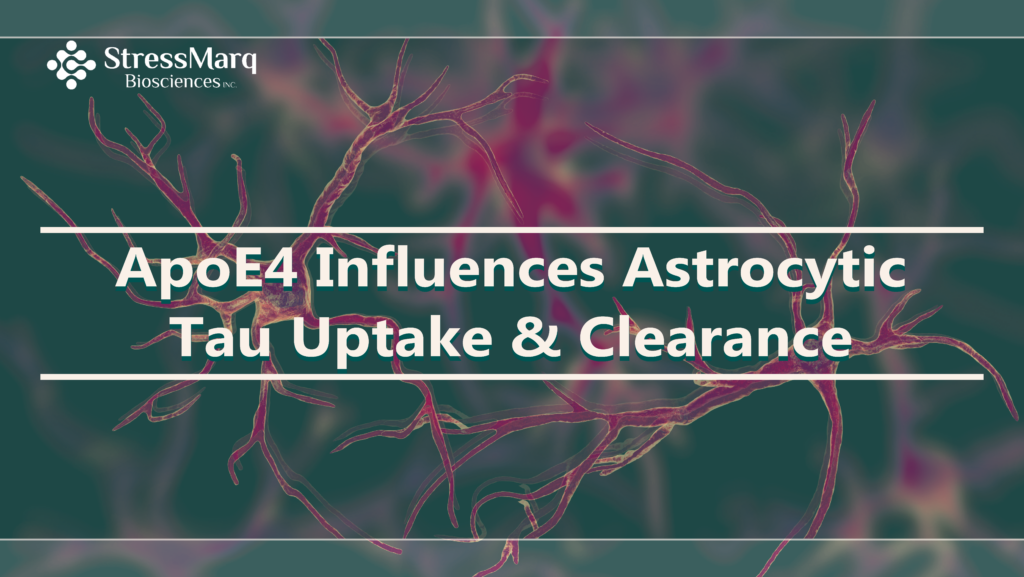ApoE4 Influences Astrocytic Tau Uptake & Clearance
Neurodegenerative diseases involving tau aggregation and amyloid beta proteins in neurons and glia are known as tauopathies. The most common tauopathy is Alzheimer’s disease, which typically results in a progressive loss of neurons and synapses. Astrocytes — a specialized subset of non-neuronal cells known as glia — can internalize extracellular tau released by neurons. A growing body of evidence links one of the strongest genetic risk factors for late-onset Alzheimer’s disease — apolipoprotein E (apoE4), a major cholesterol carrier — to astrocytic clearance of neurotoxic proteins. Previous findings have shown that ApoE4 expression in astrocytes confers a cytotoxic influence on endocytic mechanisms and impairs the clearance of the neurotoxic protein amyloid beta. Until now, it has remained unknown if apoE4 may have the ability to impact tau processing in a similar manner.
A recent study by Eisenbaum et al., investigates for the first time whether the expression of apoE4 in astrocytes impairs endocytic mechanisms. Researchers from the Roskamp Institute in Florida uncovered that the apoE4 genotype was associated with impaired tau uptake and endocytic processing of aggregated tau, which induced mitochondrial dysfunction — a feature commonly observed in Alzheimer’s disease. Elucidation of the mechanisms behind apoE4 impairment of tau may enhance the investigation into how neurodegeneration is accelerated by pathogenic tau regulation.
Visualizing the endocytic processing of tau
The study began by investigating the effect of apoE isoforms on astrocytic tau uptake. Human astrocytes were exposed to tau in the presence of each lipidated apoE isoform (apoE2, apoE3 and apoE4). Tau uptake by astrocytes was shown to be apoE isoform-specific, with only apoE4 being able to reduce tau internalization. Moreover, astrocyte tau uptake was observed to be at least partially mediated by the apoE receptor, LRP1.
Next, it was important to visualize the endo-lysosomal trafficking of tau. To study the influence of apoE4 on this pathway, apoE4-targeted replacement mice were generated by the targeted replacement of the endogenous murine APOE4 gene with the human APOE4 gene. Control experiments employed targeted replacement of other apoE isoforms. Astrocytes were then isolated from the mice and exposed to StressMarq’s ATTO 488 conjugated Human Recombinant Tau-441 (2N4R) P301S Mutant Pre-formed Fibrils (catalog# SPR-329-A488). Endosomal trafficking of aggregated tau could subsequently be monitored using immunostaining.
ApoE4 astrocytes colocalized with early endosomal (EEA1) compartments, like the other apoE isoforms. However, colocalization with the late endosomal marker (Rab7) was diminished, which contrasted with the other apoE isoforms. The data produced was consistent with the trafficking of amyloid beta. Collectively, the data suggested that apoE4 induced delays in tau processing through the endosomal-exosomal pathway, resulting in elevated tau retention within astrocytes despite reduced uptake.
ApoE4 expression causes mitochondrial dysfunction
The study then progressed to examine the downstream effects of the perturbation in endosomal trafficking caused by apoE4. The expression of pathogenic tau revealed impaired mitochondrial function in astrocytes. This disruption of mitochondrial tau regulation was confirmed by transcriptomic analysis. Mitochondrial oxidative phosphorylation, which occurs in the absence of glucose in astrocytes, can be assessed by measuring ATP levels.
By exposing immortalized mouse apoE4 astrocytes to various concentrations of StressMarq’s Human Recombinant Tau-441 (2N4R) Wild-Type Monomers (catalog# SPR-479), scientists were able to evaluate mitochondrial ATP production. No inhibitory effect was observed following the introduction of monomeric tau. Conversely, pathogenic Human Recombinant Tau-441 (2N4R) Wild-Type Pre-formed Fibrils (catalog# SPR-480) from StressMarq impaired ATP production by 26-fold at a concentration of 100 nM, thus indicating mitochondrial dysfunction.
Links with traumatic brain injury
Another interesting aspect of the study focused on the association between traumatic brain injury (TBI) and an increased risk of neurodegenerative diseases, including Alzheimer’s disease. Repetitive mild traumatic brain injury was shown to exacerbate the apoE4-induced impairments in tau processing and elimination. The results suggested that apoE4 lowered the brain’s resilience to tau accumulation, rendering it more susceptible to the development of neurodegenerative diseases.
Utilizing StressMarq products to examine tau clearance
ApoE4 is an identified genetic risk factor for late-onset Alzheimer’s disease. Visualization of the endocytic trafficking of tau in both primary and immortalised astrocytes was achieved using StressMarq’s fluorescent Human Recombinant Tau-441 (2N4R) P301S Mutant Pre-formed Fibrils: ATTO 488 (catalog# SPR-329-A488). This mutant form of tau exhibits significant features of Alzheimer’s disease, including abundant filamentous tau inclusions. Monomeric (catalog# SPR-479) and fibrillar forms (catalog# SPR-480) of the longest isoforms of tau were used to investigate the influence of apoE4 on tau uptake, trafficking, and clearance in astrocytes.
Figure 1. StressMarq’s ATTO 488-conjugated Human Recombinant Tau-441 (2N4R) P301S Mutant Pre-formed Fibrils (catalog# SPR-329-A488) imaged using Transmission Electron Microscopy (TEM).
Summary
Astrocytes expressing apoE4 have exhibited detrimental impairment of the clearance of the neurotoxic protein amyloid beta. The study by Eisenbaum et al. dissects how the expression of apoE4 is also capable of disrupting the endocytic mechanisms underlying tau clearance. The consequent mitochondrial dysfunction is frequently observed as a symptom of Alzheimer’s disease. Furthermore, the study examined the importance of apoE expression in the context of exposure to traumatic brain injury (TBI). The results have furthered the understanding of the role of glial cells in Alzheimer’s disease and the complex factors contributing to neurological decline.
Related StressMarq products
StressMarq is the market leader of unique fibrillar, oligomeric, and monomeric protein preparations for neurodegenerative disease research. Visit our website for details on tau, amyloid beta, and alpha synuclein proteins, including a list of other scientific publications where our products have been used.
References
- ApoE4 expression disrupts tau uptake, trafficking, and clearance in astrocytes. Eisenbaum, M. et al. Glia 2024.
- Amyloid clearance defect in ApoE4 astrocytes is reversed by epigenetic correction of endosomal pH. Prasad, H., et al. PNAS 2018.


![StressMarq’s Human Recombinant Tau-441 (2N4R) P301S Mutant Pre-formed Fibrils: ATTO 488 (catalog# SPR-329-A488) TEM]](https://www.stressmarq.com/wp-content/uploads/SPR-329-A488_Tau-Protein-Protein-TEM-2-291x300.png)
Leave a Reply